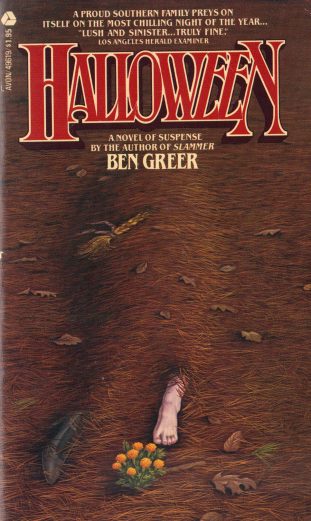 HALLOWEEN by BEN GREER, despite its title and 1978 publication date, has nothing to with the John Carpenter directed HALLOWEEN. That film is infinitely preferable to this tedious attempt at horrific suspense that’s set, as its title portends, on Halloween.
HALLOWEEN by BEN GREER, despite its title and 1978 publication date, has nothing to with the John Carpenter directed HALLOWEEN. That film is infinitely preferable to this tedious attempt at horrific suspense that’s set, as its title portends, on Halloween.
The protagonist is Blake Pasque, who returns to the Southern port town where he grew up after years of residing elsewhere. Blake, we learn, was eager to get away from his insanely dysfunctional family, but has returned to save his mentally unstable mother Jess—traumatized by the suspicious death of her husband—from being institutionalized by her asshole brother Cross. There’s a psychopath loose in the area who when he’s not mutilating small animals stalks Blake and Jess. As the story advances we learn that the psycho, a Plato-quoting freak named Raphael, was previously interred in a nuthouse together with Jess. We also learn that Raphael has been hired by Cross to kill Jess—just as Cross did to her husband and evidently intends to do to Blake. The frustrating thing about this novel is that it contains some authentically good things. The author has a gift for characterization, which is particularly evident in the impossibly vile Cross, who’s about as perfect an example of unfiltered evil as any I’ve encountered. Yet even here there’s a problem, as all the characters are uniformly selfish and manipulative, to the point that I found it difficult to care about their fates, much less continue reading.
1979’s HALLOWEEN by CURTIS RICHARDS is related to the aforementioned John Carpenter film, being a novelization of same, and a strong enough piece of work in its own right that Carpenter actually used elements 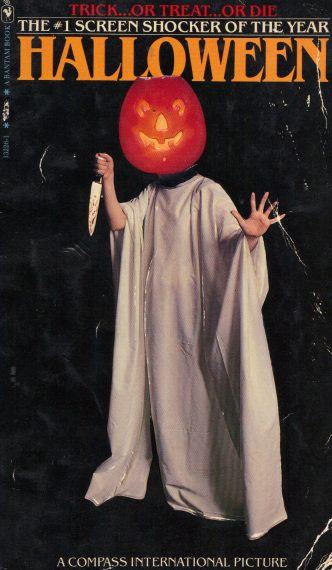 from it in his script for HALLOWEEN II.
from it in his script for HALLOWEEN II.
Richards wreaks some minor but crucial changes on Carpenter and Debra Hill’s HALLOWEEN screenplay. The soulless Michael Myers is here given a supernatural rationale for his psychosis, which is directly tied to the powers invoked by the ritual of Samhain, the Druid festival of the dead. As we all know, the youthful Myers stabs to death his older sister, for which he’s interred in a mental hospital for the next fifteen years. He breaks out to terrorize a bunch of teen babysitters before he’s finally brought down—or so it seems—by the determined Dr. Loomis.
Cliff Richards admittedly never quite succeeds in replicating the film’s keenly wrought suspense, but makes up for that lack with some profoundly impacting death scenes that convey the true horror of Michael Myers’ insanity (“in her last moment she was aware of a blend of surprise and regret that the event could be so peaceful and undramatic”). Richards also slyly comments on the narrative’s occasional implausibilities, as in the knowing passage “Nice going, Laurie, she said to herself. Why didn’t you just shout, “I’m in here, Mr. Murderer!” This novel is hardly a masterpiece for the ages, but taken for what it is its damn fine, and very nearly a must-read.
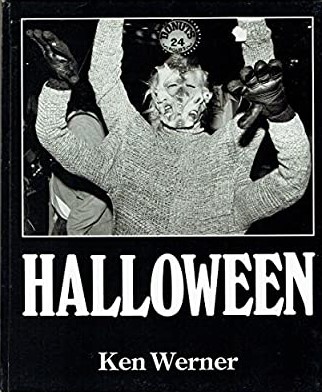 1981’s HALLOWEEN is a now rare and out-of-print large format hardcover, consisting of around 50 black-and-white photographic reproductions depicting the polysexual insanity that took place during the notorious Halloween parties held on San Francisco’s Polk and Castro Streets in the late seventies. The photographer was KEN WERNER, who has an eye for the freakish and bizarre reminiscent of Diane Arbus.
1981’s HALLOWEEN is a now rare and out-of-print large format hardcover, consisting of around 50 black-and-white photographic reproductions depicting the polysexual insanity that took place during the notorious Halloween parties held on San Francisco’s Polk and Castro Streets in the late seventies. The photographer was KEN WERNER, who has an eye for the freakish and bizarre reminiscent of Diane Arbus.
Among the wild, outrageous and bleakly humorous sights on display here are a man slow dancing with a blow up mannequin, a four-armed costume topped off by a two faced mask, a guy seen from behind whose shirt is cut open to expose a drawing of a naked woman’s torso on his back, a person wearing a giant full body condom and so forth. Werner also provides a textual introduction outlining the history of San Francisco’s Halloween festivities, and how (as of 1981) they were in danger of being phased out.
The 2002 kid book HALLOWEEN emerged from the celebrity children’s book craze of the 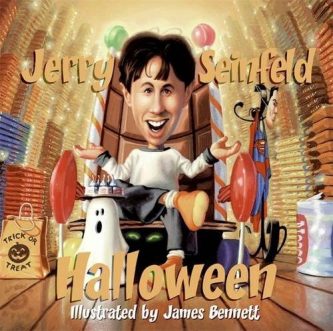 00s, with famous folks like Jamie Lee Curtis, Whoopie Goldberg, Carl Reiner, Jay Leno, LeAnn Rimes, Joy Behar, Jimmy Fallon, Madonna, John Lithgow, Billy Crystal, Julianne Moore and many others trying their hands at kid lit. The author in this case was JERRY SEINFELD, who provides an extended kid-friendly riff on all things Halloween-related.
00s, with famous folks like Jamie Lee Curtis, Whoopie Goldberg, Carl Reiner, Jay Leno, LeAnn Rimes, Joy Behar, Jimmy Fallon, Madonna, John Lithgow, Billy Crystal, Julianne Moore and many others trying their hands at kid lit. The author in this case was JERRY SEINFELD, who provides an extended kid-friendly riff on all things Halloween-related.
For Seinfeld Halloween entails the getting of candy, for which his childhood self will do anything: “I’ll wear whatever I have to wear. I’ll do anything I have to do to get candy from those fools who are so stupidly giving it away.” Also included is a great deal of Seinfeld’s patented observational humor, as in a riff on how for kids everything is “up” (“Wait Up!” “Hold Up!” “Shut Up!”), while for adults everything is “down” (“Slow Down!” “Calm Down!” “Sit Down!”). The goofily exaggerated illustrations by James Bennett depict a mini-Jerry Seinfeld engaged in the various antics described in the text, which is often presented in similarly goofy, oversized fonts.
What I might have thought of this book as a kid I have no idea, but as an adult I was a bit underwhelmed, not least because the one angle integral to Halloween—the scary one—is nowhere to be found.
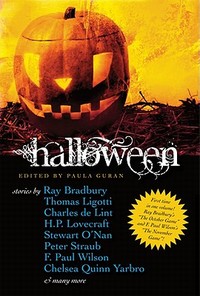 2011’s HALLOWEEN, edited by PAULA GURAN, is an anthology about—you guessed it—Halloween. Nearly all the tales are strong, and a few even qualify as great; it’s curious, then, that I found the overall book underwhelming. The problem may be with the subject matter, which doesn’t allow for much in the way of macabre invention, seeing as how Halloween is by its very nature all about scares.
2011’s HALLOWEEN, edited by PAULA GURAN, is an anthology about—you guessed it—Halloween. Nearly all the tales are strong, and a few even qualify as great; it’s curious, then, that I found the overall book underwhelming. The problem may be with the subject matter, which doesn’t allow for much in the way of macabre invention, seeing as how Halloween is by its very nature all about scares.
A lack of invention, in fact, is a common factor of these stories, whose conceptions include familiar conceits like a forbidding personage showing up on or around Halloween whose presence portends bad things (as in “The Halloween Man” by William F. Nolan and “Memories” by Peter Crowther), scary pumpkin-headed dudes (as in “Auntie Elspeth’s Halloween Story” by Esther M. Friesner and “Pumpkin Night” by Gary McMahon) and the old real-ghouls-turning-up-amid-the-costumed-ones gag (as in “Pranks” by Nina Kiriki Hoffman and “The Universal Soldier” by Charles de Lint).
A superior entry is “Monsters” by Stuart O’Nan, about a young boy involved in a horrific accident whose brilliance is in its consistently unpredictable, reality-centered depiction of what befalls that boy, his friends and his family. Another standout is the novella-length “Pork Pie Hat” by Peter Straub, about a most horrific childhood memory related by an aging jazz maestro that really showcases Straub’s talents for crafting vivid characterizations and hallucinatory horror. I also appreciated “Hornets” by Al Sarrantonio, an author who has made Halloween his own, and effectively uses it in this unnerving account of a tormented writer, his missing wife and an inexplicable hornet infestation. There’s also the magnificently unnerving “On a Dark October,” a brief bit of unalloyed ugliness by Joe R. Lansdale.
So there’s some good stuff here. The collection, once again, isn’t one of my favorites, but you could certainly do much worse.
